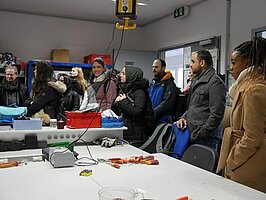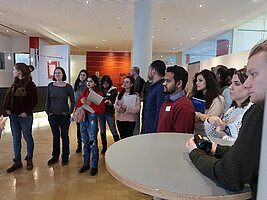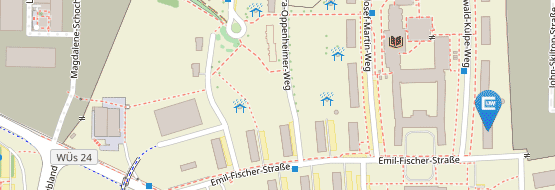Academic Knowledge meets Practice


Aim of the strategy/method
- to make academic knowledge relevant to practice settings
- to make students competent in applying academic knowledge in practice
- to understand the gap between academic knowledge and the needs of practice and learn how to overcome the gap
- to learn how to analyse and reflect on observed practice based on academic knowledge (in groups)
Setting
- Classroom with moveable tables and chairs
- Field visits to local adult/continuing education providers (e.g. chambers of industry and commerce)
- Classroom with moveable tables and chairs
Type and name of the course, curriculum, number of students
- Master’s-level studies in education, adult education module, 25 participants
Description of the method/strategy
The strategy has several phases and may be realized in a series of consecutive sessions.
- Phase 1 (e.g. 1 session of 2 hours each week during one semester): Students read academic texts on adult education and discuss them in groups. Students may do so individually, or they may be partially guided by specific criteria. In my example, we do this in the context of programme planning in adult and continuing education.
- Phase 2 (e.g. 1 or 2 sessions during the semester): Based on their understanding of the text and its concepts (e.g. needs vs. desires, target groups vs. participants, programme vs offerings), students in the group identify attributes/characteristics to be observed (or asked for) in adult education practice with regard to the concepts above. These attributes then form the structure of the observation grid. Afterwards, each attribute is operationalised using a question that may be asked in practice to get information about it. The observation grid discussed within the group then becomes a guide for the field visit, which follows in phase 3.
- Phase 3 (about 2 hours): During phase 3, the group goes on a field visit together. The colleagues from the field of adult education are asked to present their organisation. Afterwards, students ask questions on any attributes they may still need more information about.
- Phase 4 (e.g. 1 session of 2 hours during one semester): Afterwards, the group meets again in class to reflect on the results of their observation. This leads to an interrelation of academic knowledge/concepts and practical observation. It also leads to a substantial critical perspective on academic concepts and knowledge.
Materials required
- Academic texts that provide concepts to be easily observed by students; posters, markers for developing the observation grid; organised field visit
Origin and theoretical framework
- The method is developed based on the following theoretical discussions, which refer to the discourse about professionalisation in adult education in Germany:
- Tietgens (1988): professionalism as ‘the ability to use broad, scientifically deepened and diverse abstract knowledge adequate in concrete situations. Or contrariwise: to acknowledge in just these situations which parts of the knowledge could be relevant’.
- Gieseke (2010): professionalism as ‘differentiated handling with research results of the discipline, together with interdisciplinary knowledge for the interpretation of an actor’s situations in a specific practical field’.
- The method was developed by Regina Egetenmeyer, originally as part of the Mentoring-to-Teach Project (see below). The idea is to design a didactical approach to enable young students to develop professionalism as outlined by Tietgens and Gieseke.
- Mentoring-to-Teach Approach: https://www.paedagogik.uni-wuerzburg.de/erwachsenenbildung/studium/bachelor-paedagogik/mentoring-to-teach/
Risks and advantages
Advantages:
- The method allows for educating students towards competences and for using academic knowledge in a substantial way for reflections on practice.
- The method teachers students how to read academic texts in (adult) education.
- The method supports ongoing contacts with the field of practice in adult education.
- The reflection phase shows the different perspectives that participants have on the field. It helps students understand the value of teamwork and different perspectives.
- The field visit motivates students to read texts properly and to raise adequate questions during the field visit. This perspective strengthens students’ recognition of the study programme within the practice field of adult education.
Risks:
- The method takes time, and field visits need to be prepared properly and well in advance.
- Students need a minimum knowledge about empirical research to be able to identify observable attributes from academic texts. Otherwise, it is advisable to provide intensive guidance to students intensively when developing observable attributes.
Possible variations
- I also use the strategy in bachelor’s-level studies:
- For the first year, I work on educational tasks and educational institutions. To that end, I prepare the observation grid to be used by the students.
- For second-year students, we have developed the Mentoring-to-Teach approach, in which didactical theories and principles are discussed.
- For these theories, an observation grid is developed. Afterwards, students get to observe a full (two-day) adult education course. Before and after the course, students ask the practitioners (= mentors) questions to understand the concept and the methods of the course. Afterwards, students return to the classroom, and the didactical theories and principles are discussed in class. Based on this discussion, students learn how to use didactical theories.
Other examples where you think it could be used
- It may be used for all settings in which academic concepts cannot be applied directly but are used for understanding empirical/practice situations.
Recommendation
- It is helpful to select very detailed readings, providing concepts that may be operationalised in observable attributes.
- The method is very helpful for building long-term contacts to the field of practice. Because they come to the field visit well prepared, students normally ask good questions, which also leaves practitioners with a good impression of students’ knowledge.
References
Gieseke, W. (2010). Professionalität und Professionalisierung. In R. Arnold, S. Nolda, & E. Nuissl (Eds.), Wörterbuch Erwachsenenbildung. 2nd, revised edition (pp. 243-244). Bad Heilbrunn: add publisher.
Tietgens, H. (1988). Professionalität für die Erwachsenenbildung. In W. Gieseke (Ed.), Professionalität und Professionalisierung. Reihe: Theorie und Praxis der Erwachsenenbildung (pp. 28–75). Bad Heilbrunn: Klinkhardt.
Contact Person
Regina Egetenmeyer (regina.egetenmeyer@uni-wuerzburg.de)


